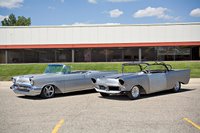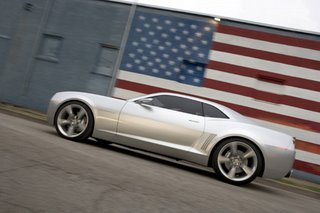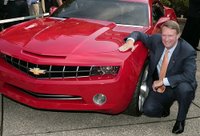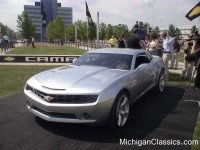Horsepower war Nicolas Van Praet
Source -
National Post - Thursday, August 10, 2006
A new horsepower war is looming between North America's traditional Big Three automakers as each reaches into its classic muscle car stable in an attempt to woo nostalgic car buyers.
Ford Motor Co. fired the first shot, launching a redesigned version of its flagship Mustang for 2005 that has sold more than 175,000 units, including 10,000 in Canada last year. Then DaimlerChrysler AG revealed last month it would build a modern version of the testosterone-charged Challenger.
General Motors Corp. is widely expected to join the party today with an announcement it will bring back the Camaro. Ontario assembly plants are favoured to build both the Camaro and the Challenger.
By 2008, all three redesigned muscle cars are expected in showrooms as the Detroit automakers try to win over consumers who ditched them in favour of Asian brands such as Toyota in recent years.
"What it really comes down to is putting cars on the street that turn people's heads and makes them say 'Wow, what is that? I want one,'" said Peter DeLorenzo, an auto industry consultant and editor of autoextremist.com.
"The domestics used to be able to do that. And they're rediscovering it.
"At this point, I think it's what the U.S. manufacturers have to do. They have to at least attempt to capture the imagination of the American consumer, which they've had difficulty doing for the last decade."
Detroit could use a jump-start.
The city's new muscle car designs have been splashed on the covers of recent auto enthusiast magazines and have won rave reviews at auto shows. But in the mass market, buyers are picking foreign-based brands in increasing numbers.
So far this year, a majority of new vehicles registered in the U.S. by new buyers were import brands, consultancy R.L. Polk & Co. said. It marked the first time that foreign nameplates outpaced the traditional American brands in that country. Toyota outsold Ford for the first time last month in the U.S., the world's biggest auto market.
These new offerings by the Big Three may not change that. But they will at least trigger some positive excitement about their passenger cars, said Erich Merkle, an analyst with IRN Inc. in Grand Rapids, Michigan.
"The Mustang alone will not save Ford. The Camaro is not going to save General Motors. And the Challenger is not going to really do a whole lot to help Chrysler out. But they do make for really nice halo vehicles that certainly generate a lot of buzz and showroom traffic. That's for sure."
Like the Mustang, the Camaro is expected to come with an optional V6 engine, which is more fuel efficient than the V8 and will appeal to a wider range of buyers, analysts said. GM is aiming to sell 100,000 Camaros, they said. The Challenger will likely be more of a niche vehicle because it will come with a V8 motor only.
Some original American hot cars like the Plymouth Barracuda are commanding million-dollar prices at auction houses and Chrysler and its rivals are hoping to cash in on their popularity.
"That resonance now is very high," Chrysler Group chief operating officer Eric Ridenour said in an interview last month. With the Challenger's 2008 launch, Chrysler "should be able to hit this market while peaking," he said.
Marketing experts like John Grace of Brand-Taxi have suggested the surge of interest in Detroit's glory-day cars may be the result of U.S. consumers reaching back to the past to sooth the present-day anxiety they may feel as a result of hostility against their country. American cars like the 1959 Caddy and 1967 Pontiac GTO, with their massive tailfins and aggressive design, represented a time when the U.S. had an unabashed swagger and confidence, the argument goes.
But nostalgia doesn't necessarily translate to large scale profitability.
Critics doubt whether the cars will make it in an era when US$3-a-gallon gasoline appears to be the new norm, even if their V6 engines suck less gas than their predecessors. Yesterday, Ford executive vice-president Mark Fields said demand for fuel-efficient vehicles is more permanent than the company had expected.
There are also questions about how creatively Ford and GM can tap into their past designs, more than just by bringing out a straight re-do of a previous model. Only Chrysler has so far successfully blended design cues from the past into the modern designs of more mainstream vehicles like its 300C and the Dodge Charger, Mr. Merkle said.
"You have to go someplace where the Japanese aren't and that's going to be in the area of design," Mr. Merkle said.
GM last built the Camaro at its now-razed plant in Boisbriand, Que. in 2002. Its Oshawa plant is in line to build the re-design.
GM Canada managers submitted a business case to the company's board of directors last month proposing a flexible manufacturing operation at the Oshawa facility, which would build the new Camaro as well as several other rear-wheel drive vehicles.
The Canadian Auto Workers union and GM have negotiated a new deal on work conditions for the Oshawa facilities in order to secure investment for the new models.















